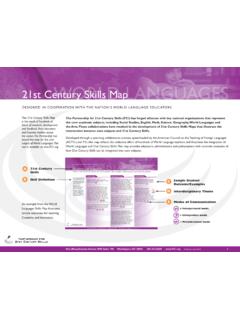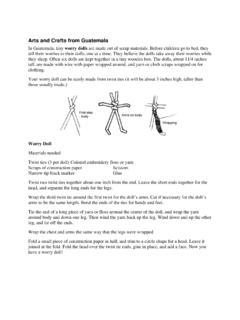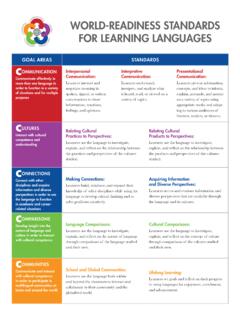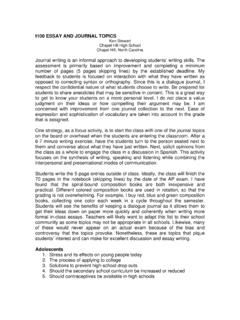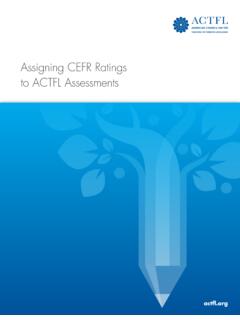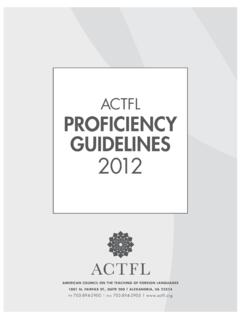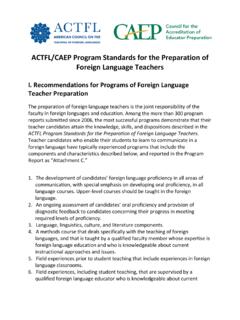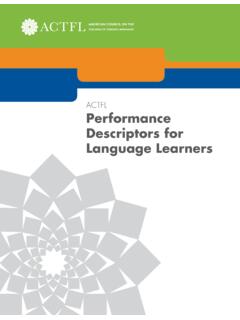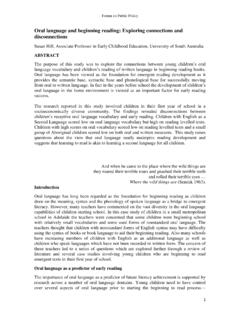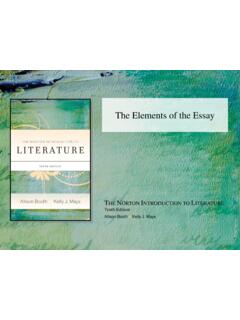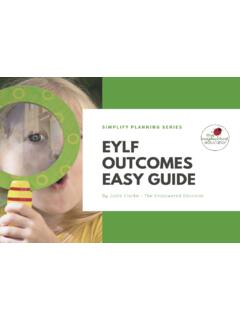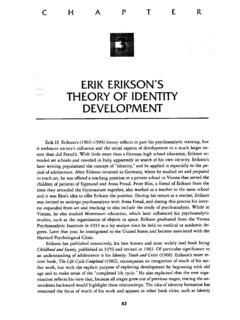Transcription of NCSSFL-ACTFL CAN-DO STATEMENTS PROFICIENCY …
1 NCSSFL-ACTFL CAN-DO STATEMENTS : PERFORMANCE INDICATORS FOR LANGUAGE LEARNERS 2 0171 NOVICEPROFICIENCY BENCHMARKINTERMEDIATEPROFICIENCY BENCHMARKADVANCEDPROFICIENCY BENCHMARKSUPERIORPROFICIENCY BENCHMARKDISTINGUISHEDPROFICIENCY BENCHMARKCOMMUNICATIONCOMMUNICATIONINTER PRETIVEI can identify the general topic and some basic information in both very familiar and everyday contexts by recognizing practiced or memorized words, phrases, and simple sentences in texts that are spoken, written, or can understand the main idea and some pieces of information on familiar topics from sentences and series of connected sentences within texts that are spoken, written, or can understand the main message and supporting details on a wide variety of familiar and general interest topics across various time frames from complex, organized texts that are spoken, written, or can interpret and infer meaning from complex, academic and professional texts on a range of unfamiliar, abstract, and specialized issues that are spoken, written.
2 Or can interpret and infer meaning from dense, structurally sophisticated texts on a wide range of global issues and highly abstract concepts, with deeply embedded cultural references and colloquialisms and dialects that are spoken, written, or can communicate in spontaneous spoken, written, or signed conversations on both very familiar and everyday topics, using a variety of practiced or memorized words, phrases, simple sentences, and can participate in spontaneous spoken, written, or signed conversations on familiar topics, creating sentences and series of sentences to ask and answer a variety of can maintain spontaneous spoken, written, or signed conversations and discussions across various time frames on familiar, as well as unfamiliar, concrete topics, using series of connected sentences and probing can participate fully and effectively in spontaneous spoken, written, or signed discussions and debates on issues and ideas ranging from broad general interests to my areas of specialized expertise, including supporting arguments and exploring can interact, negotiate.
3 And debate on a wide range of global issues and highly abstract concepts, fully adapting to the cultural context of the conversation, using spoken, written, or signed can present information on both very familiar and everyday topics using a variety of practiced or memorized words, phrases, and simple sentences through spoken, written, or signed can communicate information, make presentations, and express my thoughts about familiar topics, using sentences and series of connected sentences through spoken, written, or signed can deliver detailed and organized presentations on familiar as well as unfamiliar concrete topics, in paragraphs and using various time frames through spoken, written, or signed can deliver extended presentations on abstract or hypothetical issues and ideas ranging from broad general interests to my areas of specialized expertise, with precision of expression and to a wide variety of audiences, using spoken, written, or signed can deliver sophisticated and articulate presentations on a wide range of global issues and highly abstract concepts.
4 Fully adapting to the cultural context of the audience, using spoken, written, or signed COMMUNICATIONINTERCULTURAL COMMUNICATIONINVESTIGATE In my own and other cultures I can identify products and practices to help me understand my own and other cultures I can make comparisons between products and practices to help me understand my own and other cultures I can explain some diversity among products and practices and how it relates to my own and other cultures I can suspend judgment while critically examining products, practices, and my own and other cultures I can objectively evaluate products and practices and mediate I can interact at a survival level in some familiar everyday contexts.
5 I can interact at a functional level in some familiar contexts. I can interact at a competent level in familiar and some unfamiliar contexts. I can interact in complex situations to ensure a shared understanding of can engage with complexity and pluricultural identities and serve as a mediator between and among CAN-DO STATEMENTSPROFICIENCY BENCHMARKSNCSSFL-ACTFL CAN-DO STATEMENTS : PERFORMANCE INDICATORS FOR LANGUAGE LEARNERS 2 0172 INTERPRETIVE COMMUNICATIONPROFICIENCY BENCHMARKS + PERFORMANCE INDICATORSPROFICIENCY BENCHMARKI can identify the general topic and some basic information in both very familiar and everyday contexts by recognizing practiced or memorized words, phrases, and simple sentences in texts that are spoken, written, or can I understand, interpret or analyze in authentic informational texts that I hear, read or view?
6 PERFORMANCE INDICATORSNOVICE LOWNOVICE MIDNOVICE HIGHI can identify memorized or familiar words when they are supported by gestures or visuals in informational can identify some basic facts from memorized or familiar words and phrases when they are supported by gestures or visuals in informational can identify the topic and some isolated facts from simple sentences in informational can I understand, interpret or analyze in authentic fi ctional texts that I hear, read or view?PERFORMANCE INDICATORSNOVICE LOWNOVICE MIDNOVICE HIGHI can identify memorized or familiar words when they are supported by gestures or visuals in fi ctional can identify some basic facts from memorized or familiar words and phrases when they are supported by gestures or visuals in fi ctional can identify the topic and some isolated elements from simple sentences in short fi ctional can I understand, interpret or analyze in conversations and discussionsthat I hear, read or view, in which I am not a participant?
7 PERFORMANCE INDICATORSNOVICE LOWNOVICE MIDNOVICE HIGHI can understand memorized or familiar words when they are supported by gestures or visuals in can identify some basic facts from memorized or familiar words and phrases when they are supported by gestures or visuals in can understand familiar questions and STATEMENTS from simple sentences in elements of literacy lead to higher levels of understanding in the Interpretive Mode?Learners move along the profi ciency continuum at different speeds in listening, reading or viewing. Learners bring prior skills and experience in L1 and L2 to the Interpretive mode.
8 Factors that impact how well learners understand texts include:a) text complexity or lengthb) familiarity with topic and background knowledgec) ability to use literacy strategies such as recognizing key words, detecting the main idea, identifying supporting details, noting organizational features, guessing meaning from context, identifying logical inferences, identifying the author s perspective and cultural CAN-DO STATEMENTSNCSSFL-ACTFL CAN-DO STATEMENTSNCSSFL-ACTFL CAN-DO STATEMENTS : PERFORMANCE INDICATORS FOR LANGUAGE LEARNERS 2 0173 INTERPERSONAL COMMUNICATIONPROFICIENCY BENCHMARKS + PERFORMANCE INDICATORSPROFICIENCY BENCHMARKI can communicate in spontaneous spoken, written, or signed conversations on both very familiar and everyday topics, using a variety of practiced or memorized words, phrases, simple sentences, and can I exchange information and ideas in conversations?
9 PERFORMANCE INDICATORSNOVICE LOWNOVICE MIDNOVICE HIGHI can provide information by answering a few simple questions on very familiar topics, using practiced or memorized words and phrases, with the help of gestures or can request and provide information by asking and answering a few simple questions on very familiar and everyday topics, using a mixture of practiced or memorized words, phrases, and simple can request and provide information by asking and answering practiced and some original questions on familiar and everyday topics, using simple sentences most of the can I meet my needs or address situations in conversations?
10 PERFORMANCE INDICATORSNOVICE LOWNOVICE MIDNOVICE HIGHI can express some basic needs, using practiced or memorized words and phrases, with the help of gestures or can express basic needs related to familiar and everyday activities, using a mixture of practiced or memorized words, phrases, simple sentences, and can interact with others to meet my basic needs related to routine everyday activities, using simple sentences and questions most of the can I express, react to, and support preferences and opinions in conversations?PERFORMANCE INDICATORSNOVICE LOWNOVICE MIDNOVICE HIGHI can express
